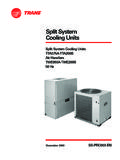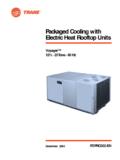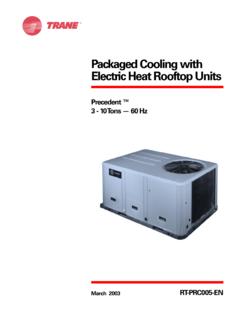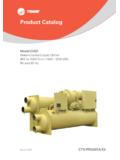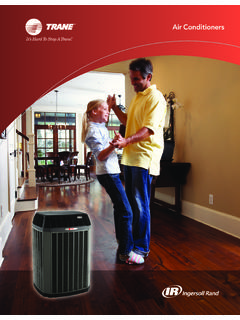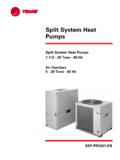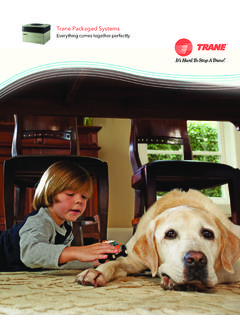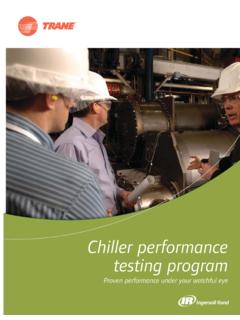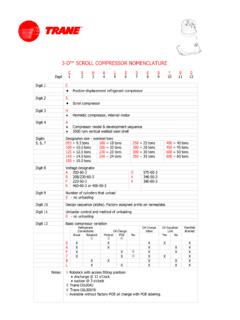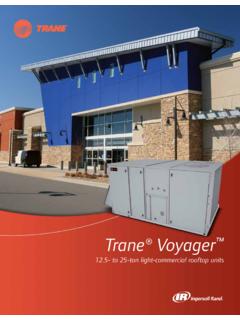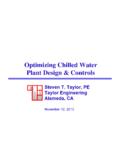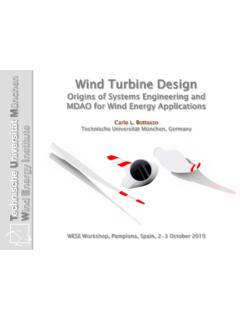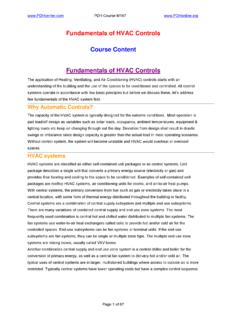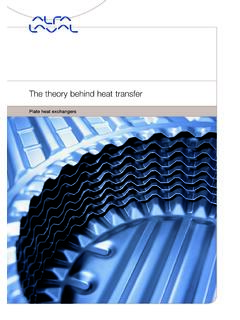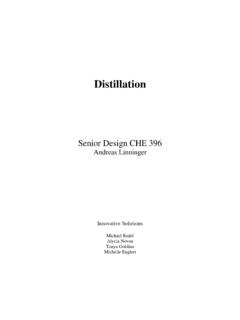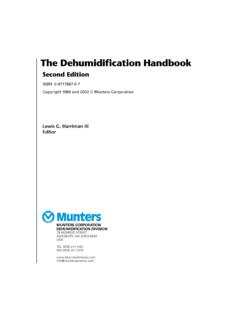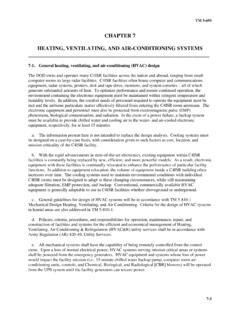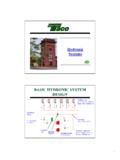Transcription of Condenser Water Temperature Control - Trane
1 November 2009 CTV-PRB006-ENEngineering BulletinCondenser Water Temperature ControlFor CenTraVac Centrifugal Chiller Systems with Tracer AdaptiView Controls 2009 Trane All rights reserved CTV-PRB006-ENIntroductionIntended specifically for HVAC system designers and Trane field sales engineers, this engineering bulletin provides information on the effect of Condenser Water Temperature on Trane centrifugal chillers with Tracer AdaptiView generation controls. It discusses various Condenser Water Temperature Control strategies for designing efficient systems and provides operating recommendations for CenTraVac , System Analyzer, TRACE, Tracer AdaptiView, Trane , and the Trane logo are trademarks of Trane in the United States and other countries.
2 Table of ContentsCTV-PRB006-EN3 Introduction .. 2 Optimizing the System .. 4 Condenser Flow Rate .. 4 Condenser Water Temperature .. 4 Economize with Outdoor Air or Free cooling .. 5 Outdoor Air Economizer .. 5 Free cooling .. 5 Guidelines for CenTraVac Chillers with Tracer AdaptiView Controls .. 7 Operating Recommendations .. 7 Direct Tracer AdaptiView Signal .. 8 Maintaining The Minimum Refrigerant Pressure Differential .. 8 cooling Tower Fan Control .. 8 cooling Tower Bypass .. 8 Chiller Bypass .. 9 Throttling Valve(s) .. 9 Variable-Speed Condenser Water Pump .. 10 Control Strategies .. 11 Chiller System Differential Pressure Logic .. 11 Sequence of Operation.
3 11 Hardware Requirements .. 12 Setup .. 12 Other Applications .. 15 Indirect Tracer AdaptiView Signal .. 17 Maintaining The Minimum Refrigerant Pressure Differential .. 17 System Design Options .. 17 cooling Tower Fan Control .. 17 cooling Tower Bypass .. 17 Chiller Bypass .. 18 Throttling Valve(s) .. 19 Variable-Speed Condenser Water Pump .. 20 Control Strategies .. 20 Sensing Condenser Refrigerant Pressure .. 20 Sensing Refrigerant Pressure Differential .. 21 Summary .. 234 CTV-PRB006-ENOptimizing the SystemCondenser Flow Rate System power , energy consumed by the chiller plant is the combined power used by the chiller(s), cooling tower, and the pumps that circulate evaporator and Condenser lowering the flow rate through the Condenser increases chiller power consumption slightly, it allows the tower to operate more efficiently and significantly reduces Condenser pumping power.
4 Generally, this reduction more than offsets the small increase in chiller consumption; that means a lower system operating cost, particularly at part-load benefits attributable to a lower-than- normal Condenser flow rate are listed below. Since some of these benefits are mutually exclusive, clearly define the design goals of the application before conducting an analysis to discover the optimal flow these factors when determining the optimal Condenser flow rate for your application: Pressure drop , high Condenser system pressure drops favor low Condenser Water flow Chiller efficiency , more efficient selections favor low Condenser Water flow Load profile , more hours at part load favor low Condenser Water flowEnergy and economic analysis tools like Trane s System Analyzer and TRACE software can help you determine the right Condenser flow rate for your application.
5 For more information on this subject, review Trane Engineers Newsletter, How Low-Flow Systems Can Help You Give Your Customers What They Want (1997 Vol. 26, No. 2).Potential low-flow benefits for ..Existing facilities: Lower pumping costs Lower leaving-tower/entering Condenser Water Temperature Lower tower operating costs Increased chiller capacity when replacing a chiller without replacing the towerAnd new facilities: Lower pumping costs Smaller, less expensive Condenser pump Smaller, less expensive Condenser Water piping Smaller, less expensive cooling tower Lower tower operating costs Lower leaving-tower/entering Condenser Water temperatureCondenser Water TemperatureCooling towers are generally selected to supply 85 F Water to the chiller Condenser at design conditions , when the ambient wet-bulb Temperature equals design and the chiller is operating at full load.
6 But these conditions rarely occur. Usually, the ambient wet-bulb Temperature is below design and the chiller is running at less than full capacity. The tower can typically provide a lower Condenser Water Temperature at these off-design chiller efficiency generally improves as the Condenser Water Temperature decreases, the lowest tower Water Temperature may not be the most economical system choice. Colder tower Water isn t free .. it requires additional fan energy. Consequently, the optimum Condenser Water Temperature ( the Temperature that minimizes system power) is an intermediate Temperature between design and as cold as possible. CTV-PRB006-EN5 Optimizing the SystemNote:For a more detailed discussion of Condenser optimization strategies, review these Trane Engineers Newsletters: Tower Water Temperature .
7 Control It How? (1995 Vol. 24, No. 1) and Chiller Plant System Performance (1989 Vol. 18, No. 2).Economize with Outdoor Air or Free CoolingThe best ways to economize are often the simplest. If the building load analysis reveals that cooling is needed when ambient temperatures are low, consider adding an outdoor air economizer or free cooling to the system. Both options provide inexpensive cooling and may reduce chiller operation and minimize system energy Air EconomizerIn many systems, outdoor air can be used for direct space cooling , provided the sensible Temperature is below 55 F and the dew point is low enough to assure that the space humidity level remains below 60 percent RH.
8 To apply this option successfully, the outdoor- and exhaust-air sections of the air handling equipment must be sized to handle the increased volume of outdoor air. Equally important are a system design and Control strategy that promotes proper humidity CoolingChiller-mounted refrigerant migration: As an option, free cooling can be fully integrated into the chiller. The benefit to this option is that no additional pumps or piping are means of free cooling is a plate-and-frame heat exchanger installed in a sidecar arrangement; see Figure 1, p. 6. Positioning the heat exchanger in series with the chiller(s) exposes it to the warmest Water in the system, extending its operating hours and : Sidecar free cooling is practical when the tower sump Temperature is at least 20 F less than the return chilled Water Temperature .
9 For more information about this design option, see Trane Engineers Newsletter, A New Era of Free cooling (1991 Vol. 20, No. 3).6 CTV-PRB006-ENOptimizing the SystemRegardless of the method used, combining chillers with free cooling requires consideration of the chiller manufacturer s Condenser Water limits. For more information, see Operating Recommendations, p. 7 in this 1. Sidecar free cooling CTV-PRB006-EN7 Guidelines for CenTraVac Chillers with Tracer AdaptiView ControlsOperating RecommendationsAll chillers require a minimum pressure difference between the Condenser and evaporator refrigerant circuits to assure proper management of oil and refrigerant, as well as hermetic motor cooling (when applicable).
10 Following are specific guidelines for CenTraVac Condenser refrigerant pressure with Tracer AdaptiView start-up .. The chiller should reach the required minimum pressure differential within 15 minutes of starting the chiller. This means that the entering Condenser Water can be very cold at the start ( , ~40 F 50 F). The chiller can start in an inverted mode where the Condenser Water is colder than the evaporator chilled Water Temperature . Running the chiller continuously for 30 minutes at the required minimum refrigerant pressure differential will assure that the oil returns to the oil tank via the oil reclaim running .. The chiller can run steady state with very cold entering tower Water .
